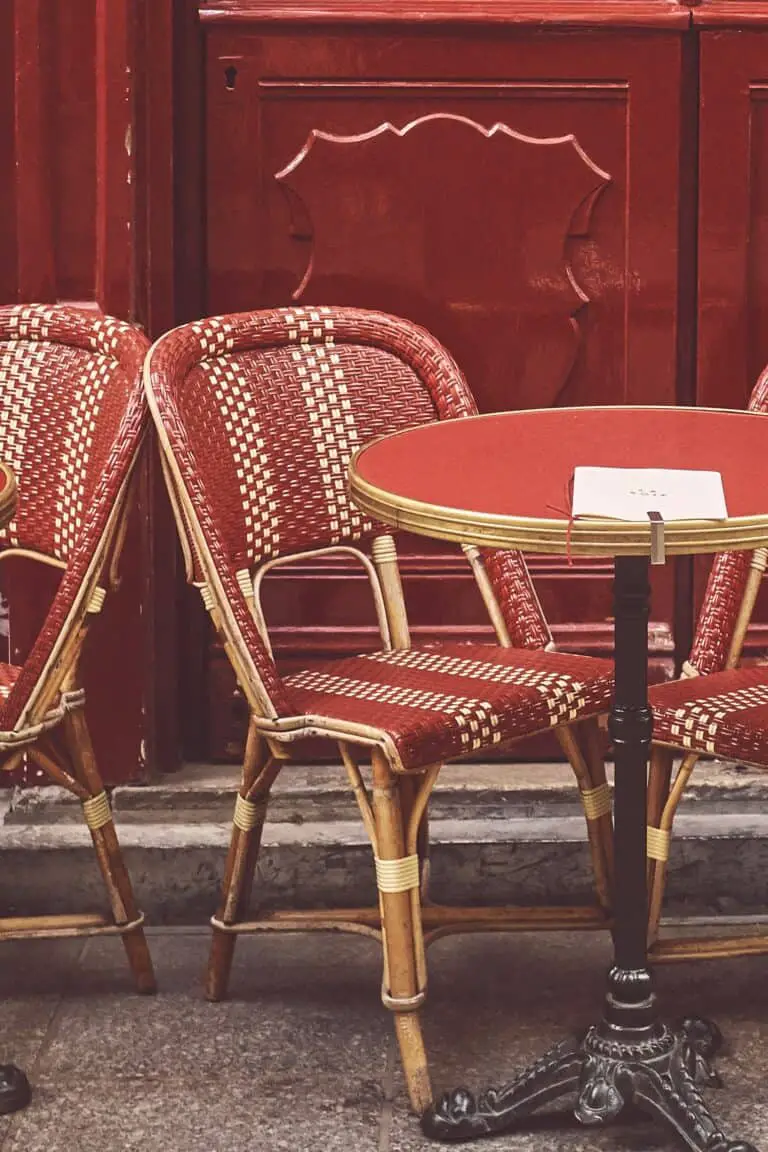What would Parisian terraces be without their famous rattan chairs? In film and literature, they are as much a part of the capital’s charm as its lampposts, Wallace fountains and kiosks. And those lucky enough to sit in one for a drink praise their comfort and lightness! An icon of urban design, an emblem of Paris and a cult object abroad, the Gatti and Drucker rattan bistro chair, made in the pure tradition of wickerwork, have been a symbol of French art de vivre for over 150 years.
Chic, trendy and unmistakable, the rattan cane chair is on display as soon as the weather turns warm. It can be seen everywhere: in blue, white and red at the Café Français in Bastille, woven in red and green at the legendary Café de Flore in Saint-Germain-des-Prés and in the Metropolitan Museum in New York. It embodies the brand image and personality of the smallest neighbourhood bistro to the most prestigious establishment in France and around the world.
Students, party-goers, the depressed, tourists, writers, the happy, the unemployed, lovers… all enjoy its comforts, but few know its history. Did you know, for example, that there are only two major brands of rattan chairs? And that they were made by hand? Let’s discover these chairs that have so much to tell.
A little history of Drucker and Gatti rattan bistro chairs
The last French manufacturers of rattan furniture for cafés, bistros, restaurants, hotels and private terraces, Maison Drucker and Maison Gatti continue the tradition thanks to the unique know-how of their craftsmen. In these factories, both of which have been awarded the Entreprises du Patrimoine Vivant (Living Heritage Companies) label, rattan makers and weavers use the famous liana palm from the equatorial forests of Southeast Asia, discovered by Dutch navigators.
The story of rattan chairs begins in Indonesia. Rattan is a vine of the palm family, several metres long, which can take on any shape when heated. Europeans discovered this wood at the end of the 19th century during the colonisation of Asia. Brought back to France, this extremely strong and flexible new material became a hit, flooding the market for armchairs, benches, screens… Louis Drucker, a small rattan manufacturer full of creativity, was one of the enthusiasts. In 1885, he set up his workshop on rue des Pyrénées, in the 20th arrondissement of Paris. Helped by the boom in terraces, he became the supplier of chairs for the great Parisian cafés and palaces such as the Grand Hôtel d’Evian in Switzerland and the Continental in Paris.
Maison Drucker: Founding Father of the Parisian Bistro Chair
This furniture was very fashionable at the time. The Maison Drucker built its reputation in the world of cafés, hotels and restaurants. Café de Flore, Les Deux Magots and Fouquet’s were among its first customers. Drucker has been decorating terraces around the world for over a century. Its rattan chairs can be found at Les Vapeurs in Trouville, Chez Riche in Stockholm and Château Marmont, Hollywood’s legendary terrace.
Drucker offers 40 models of wicker, a wide range of colours and more than 100 models of past and present creations. Now run by Bruno Dubois, with the help of his son Diego, the company is expanding into decoration, working with some of the biggest names in design. François Champsaur, Philippe Starck, India Mahdavi, Patrick Norguet and, most recently, Robert Stadler, who has revived a Drucker classic with his Corso chair, have created unique designs that give a modern twist to Drucker’s traditional creations.
Maison Gatti: Crafting Elegance in Parisian Bistro Seating
Founded in 1920 by an Italian emigrant, Gatti manufactures custom-made haute couture rattan patio furniture using artisan manufacturing principles that guarantee originality, strength and aesthetics. Hand bending, assembly and weaving techniques make these creations unique and customisable. From the Georges V in Paris to the River Café in New York, from the Rotonde in Montparnasse to the Bape Café in Tokyo, Maison Gatti offers its expertise to customers seeking the authenticity and charm of French-style terraces.
On the eve of its centenary, the company offers a choice of 80 models of chairs, armchairs, stools, benches and planters, available in over 30 weaves and 30 colours. Gatti, which has long focused on the professional sector, now caters for decorators’ projects in the hotel industry as well as for private customers. It has created exclusive colourful weaves for stylist and decorator Philippe Model and is working with architect Laura Gonzalez. A way of entering the world of private customers, who are increasingly attracted by this trend, not only for their terraces and verandas, but also for their interiors.
Gatti & Drucker rattan chairs: Custom Craftsmanship
If “real” chairs are the preserve of chic restaurants, it’s because not everyone can afford them. At Maison Drucker, for example, the average price of an armchair is between €100 and €800, and €250 for a chair. This is the price to pay for durable materials, mainly rattan and rilsan, and for handcrafted, made-to-measure products.
A symbol of Parisian elegance, the rattan chair is custom-made using a complex technical process that requires years of apprenticeship for certain tasks, such as caning. It’s all done by hand because rattan is a “living” material, not an ordinary one. Light and strong, it is very malleable and does not change. It takes six steps to make a Drucker rattan chair. First, the craftsmen prepare the components from the rattan “poles”: cutting, sanding, staining the knots, straightening and bending. The frames are then woven, the backs assembled and woven. A natural rush is then applied around the frame and chair before finishing and varnishing. The seats and backs are woven from Rilsan, a supple, durable polyamide fibre derived from castor oil. This weave allows for a wide range of patterns and colours. The frames are made of beech or exotic wood.
You then choose your model, the colours and the “caning”, i.e. the weave pattern. The chair is then assembled in 5 to 8 hours, depending on the model and type of weave. It passes through the hands of 6 or 7 craftsmen who cut and bend the rattan to give it the desired shape, weave the back and seat and assemble the whole thing, by hand of course.
Rattan making and weaving is an artistic craft. There used to be a school that trained craftsmen in rattan making, but it closed in the 1980s. Today there are virtually no workshops, no qualifications and the know-how has almost disappeared. As a Living Heritage company, our role is to train artisans for the future and pass on this rattan know-how.
A Gatti chair in numbers
It takes about 5 hours, 112 metres of Rilsan, 40 nails, staples and screws to make a chair, 22 craftsmen are present in the workshops, 34 different weaves are possible on each model. Around 820 Parisian establishments are furnished by Maison Gatti, which also sends its creations all over the world, and 6,000 pieces are made every year.
Beware of Imitations: The Authenticity of Gatti & Drucker Rattan Chairs
Rattan chairs from Parisian bistros? Far from it! It’s true that they all look the same at first glance, but it’s important to distinguish between the real thing – those handmade in France – and the imitations.
There’s only one way to do this: look for a small bronze plaque on the back of the chair. If it says Maison Drucker or Maison Gatti, bingo, they’re the real thing! This detail sets them apart from the many cheaper imitations. In fact, these two great Parisian houses are the only ones that have survived to share the French rattan chair market today, each with its own specificity. They make chairs in all colours. From azure blue to dusky pink to mint green for Maison Drucker, or from orange to aubergine for Maison Gatti. The shapes vary, from armchairs to stools, and the patterns are equally varied, in chessboard, diamond, sawtooth or staircase patterns.
Drucker and Gatti’s chairs are made with a beechwood frame and even have UV protection. Pale copies sell for around a hundred euros, while an original Drucker or Gatti chair costs 250 euros. For Drucker, if the rattan is Indonesian, it is either handmade (a chair takes 6 hours to make) in a 500m2 workshop in the Oise region of France, or (in most cases in recent years) made directly in Indonesia. They are then sold at a 40% discount. These attractive prices have allowed annual production to rise from 7,000 in the 1990s to 20,000 today, with an annual turnover of 5 million euros.
Where can you find Gatti & Drucker rattan chairs and at what price?
As mentioned above, Gatti & Drucker’s online stores offer a wide range of rattan chairs, with an average price of between €100 and €800 for a chair and €250 for a new chair. But without giving in to the temptation of buying an inferior copy, it is possible to find Gatti and Drucker rattan chairs at a lower price. But how? Well, by browsing flea markets, antique shops and online marketplaces. Indeed, many second-hand sites such as leboncoin en France, Etsy and eBay offer original Gatti and Drucker chairs at a fraction of the new price. It’s not uncommon to find chairs in good condition for €70 ($80) or even less. If you’re looking for original garden furniture, these chairs are an excellent solution. But don’t wait too long to make up your mind, as they are coming back into fashion and their prices are rising (and stocks are dwindling).
The bottom line
Over the past century, the Gatti and Drucker bistro chairs have become a symbol of Parisian flair. Crafted from brightly coloured cane and rattan frames, these chairs are celebrated for their unparalleled combination of comfort, beauty, durability and lightness. They embody a playful yet sophisticated elegance, exuding a charming ‘je ne sais quoi’ that has captivated audiences around the world. More than just furniture, these chairs represent a blend of aesthetic appeal, traditional craftsmanship and enduring quality.
While brand new models from Drucker and Gatti may be out of reach for some budgets, secondhand options offer an affordable way to add a touch of Parisian bistro chic to any space, whether it’s a balcony, garden or interior. For those eager to discover these iconic chairs, exploring local flea markets, antique dealers and online vintage stores could yield some delightful finds at enticing prices. Go on a treasure hunt for these timeless pieces and add a touch of Parisian elegance to your home.
Maison Drucker: https://www.maisonlouisdrucker.com/en/ (Instagram)
Maison Gatti: https://maison-gatti.com/ (Instagram)



